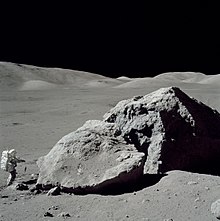
Back Astrogeologie Afrikaans جيولوجيا كوكبية Arabic Planetar geologiya Azerbaijani Astrogeologia Catalan Giàng-sĭng dê-cék-hŏk CDO Astrogeologie German Πλανητική γεωλογία Greek Astrogeología Spanish Astrogeologia Basque اخترزمینشناسی Persian

| Part of a series on |
| Geology |
|---|
 |

Planetary geology, alternatively known as astrogeology or exogeology, is a planetary science discipline concerned with the geology of celestial bodies such as planets and their moons, asteroids, comets, and meteorites.[1][2] Although the geo- prefix typically indicates topics of or relating to Earth, planetary geology is named as such for historical and convenience reasons; due to the types of investigations involved, it is closely linked with Earth-based geology. These investigations are centered around the composition, structure, processes, and history of a celestial body.[3]
Planetary geology includes such topics as determining the properties and processes of the internal structure of the terrestrial planets, and also looks at planetary volcanism and surface processes such as impact craters, fluvial and aeolian processes. The structures and compositions of the giant planets and their moons are also examined, as is the make-up of the minor bodies of the Solar System, such as asteroids, the Kuiper belt, and comets. Planetary geology largely applies concepts within the geosciences to planetary bodies in the broadest sense, includes applications derived from fields in the geological sciences, such as geophysics and geochemistry.
- ^ James F. III, Bell; Campbell, Bruce A.; Robinson, Mark S. "What is planetary geology?". Cornell University. Archived from the original on Oct 25, 2015. Retrieved 6 October 2015.
- ^ "GEOL212: Planetary Geology". University of Maryland Department of Geology. Retrieved 6 October 2015.
- ^ McSween, Harry (11 July 2019). Planetary Geoscience (1 ed.). Cambridge University Press. pp. 3–19. ISBN 978-1107145382.

